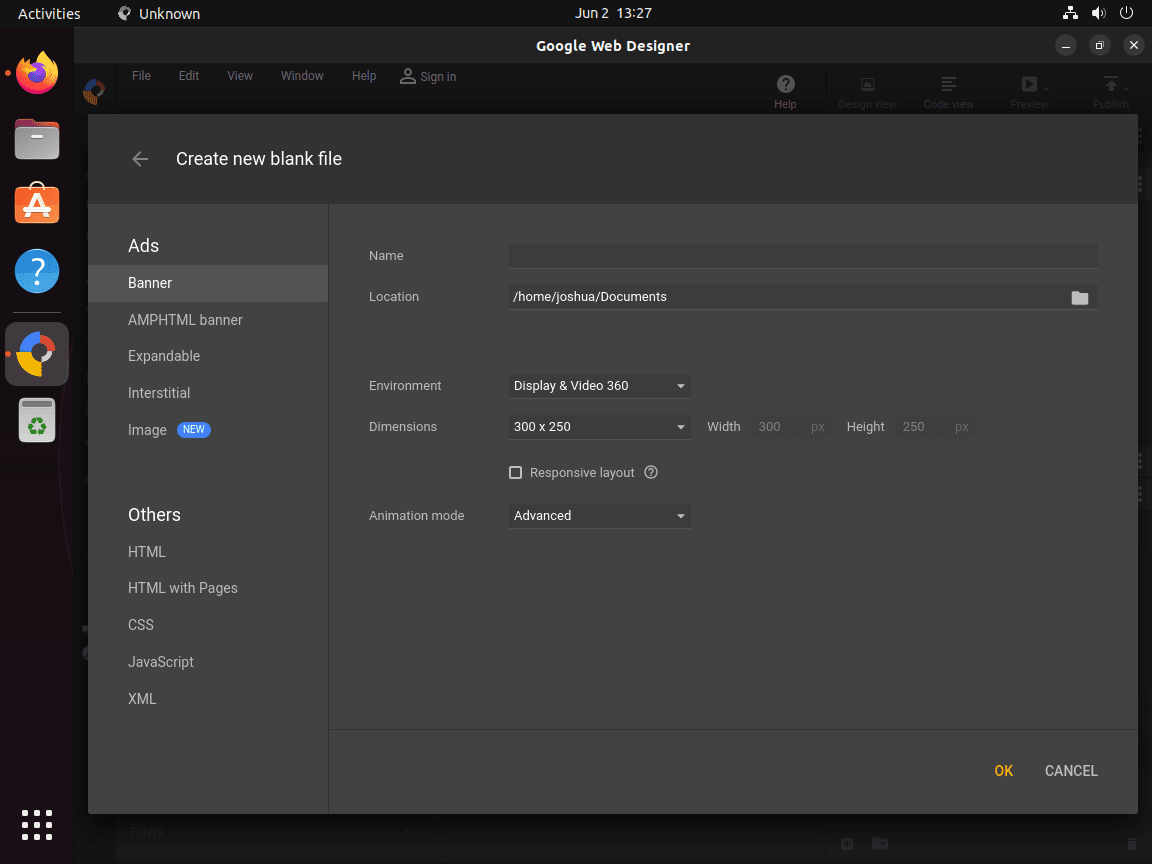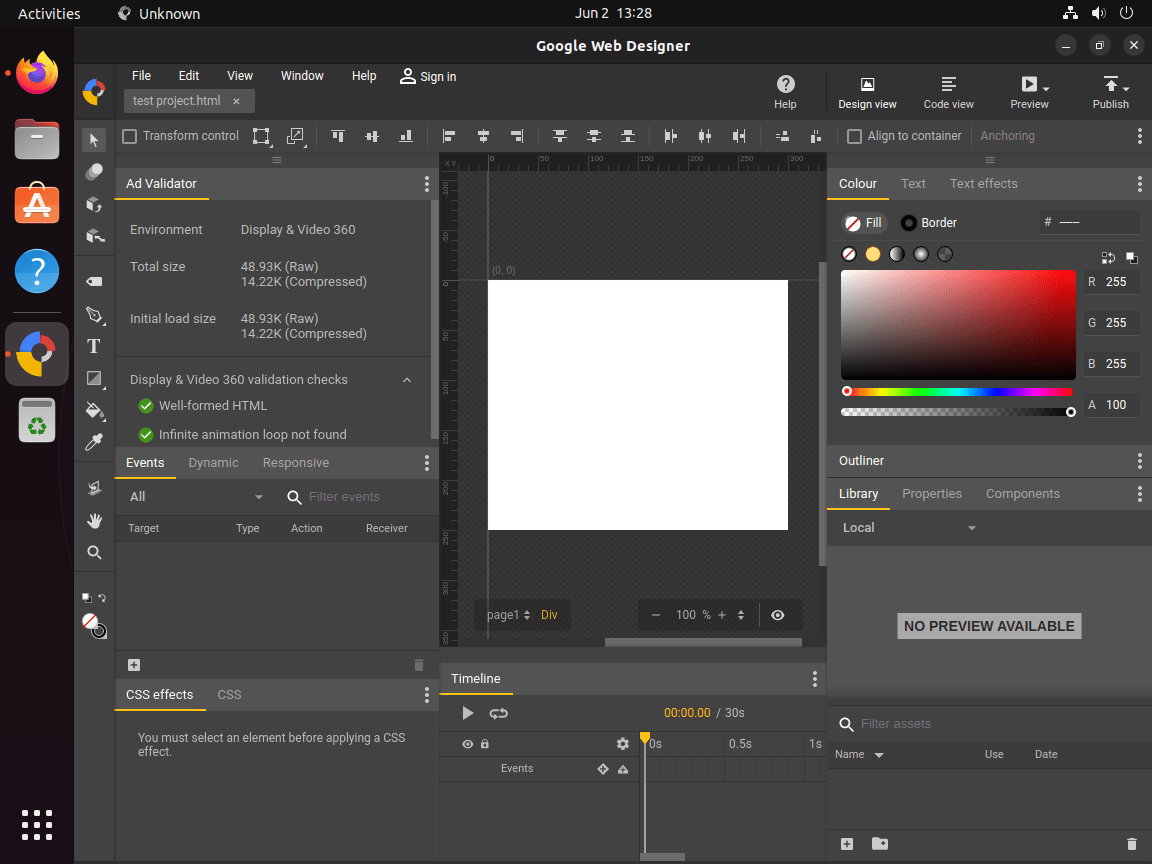This guide will demonstrate how to install Google Web Designer on Ubuntu 24.04, 22.04, or 20.04 LTS Linux releases utilizing the command-line terminal with the official Google APT repository that contains the latest builds.
Google Web Designer is a sophisticated tool engineered to streamline the creation of HTML5 ads and other web content. It offers a seamless blend of visual design capabilities with the flexibility of coding, making it an indispensable asset for designers and developers alike. At its core, Google Web Designer facilitates an intuitive environment for crafting engaging, interactive web experiences without the steep learning curve often associated with web development.
Key Features of Google Web Designer:
- Intuitive Interface: Offers a user-friendly environment for designing visually appealing web content.
- HTML5 Support: Enables the creation of HTML5-based designs, ensuring compatibility across various devices and platforms.
- Interactive Elements: Simplifies the process of adding interactive components to web projects.
- Google Services Integration: Seamlessly integrates with other Google services, enhancing the efficiency of ad campaigns and analytics.
- Responsive Design: Facilitates the creation of web content that adapts smoothly to different screen sizes.
- Animation Tools: Provides robust tools for creating smooth, animated web content.
- Visual and Code Editing: Combines the power of visual design with direct code editing capabilities.
- Extensive Library: Offers a wide range of components and templates to jumpstart the design process.
Google Web Designer bridges the gap between technical coding skills and creative design, catering to professionals seeking to enhance their web presence with dynamic, interactive content. By leveraging its comprehensive suite of tools, users can elevate their web projects, from simple ads to complex web applications, with ease and precision.
Now, let’s dive into the technical aspects of installing Google Web Designer on your Ubuntu system.
Import Google Web Designer on Ubuntu
Update Ubuntu Before Google Web Designer Installation
Begin by ensuring your Ubuntu system is up-to-date to ensure no conflicts during the installation. Open your terminal and run the following command:
sudo apt updateWith the latest package list at hand, let’s proceed to upgrade all outdated packages on your system:
sudo apt upgradeThe execution of this command upgrades all the packages in your system to their latest versions as available in the repositories.
Install Initial Packages Required for Google Web Designer Installation
Despite Google Web Designer’s generally straightforward installation process, some packages are vital to guaranteeing a smooth setup. These packages are ordinarily present in most Linux distributions, but it’s always wise to verify their existence.
To install the necessary packages, type the following command:
sudo apt install curl software-properties-common apt-transport-https ca-certificates -yThis command will install curl (used for transferring data with URLs), software-properties-common (facilitating the management of software repositories), apt-transport-https (which allows secure package downloads), and ca-certificates (containing standard SSL/TLS certificates).
Import Google Web Designer GPG & APT Repository
Installing Google Web Designer requires importing its GPG key, a crucial cryptographic identifier. The key verifies the software’s legitimacy and integrity, confirming it comes from a valid source and remains untampered.
Import the GPG key using the command below:
curl -fSsL https://dl.google.com/linux/linux_signing_key.pub | gpg --dearmor | sudo tee /usr/share/keyrings/google-web-designer.gpg > /dev/nullWith the GPG key successfully imported, we are ready to add the Google Web Designer repository. This repository is the official source from where we’ll download the software.
Run the following command to add it to your system:
echo "deb [arch=amd64 signed-by=/usr/share/keyrings/google-web-designer.gpg] http://dl.google.com/linux/webdesigner/deb/ stable main" | sudo tee /etc/apt/sources.list.d/google-web-designer.listInstall Google Web Designer on Ubuntu via APT PPA Command
With the Google Web Designer repository correctly set up and all prerequisite packages installed, we can now proceed to the main event: installing Google Web Designer.
Refresh APT Repository List After Google Web Designer PPA Import
Before installing Google Web Designer, we must refresh our APT source lists to incorporate the newly added repository. This update ensures that the package manager knows the latest metadata related to the packages in the repository.
To update the APT source list, execute the command below:
sudo apt updateInstall Google Web Designer on Ubuntu via APT Command
At this point, our system is ready to install Google Web Designer. We’ve updated our system, installed the necessary dependencies, configured the Google Web Designer repository, and refreshed our APT source list.
Installation is as straightforward as executing the following command:
sudo apt install google-webdesignerThis command instructs the package manager to fetch and install the Google Web Designer package from the configured repository.
Initiating Google Web Designer on Ubuntu via CLI or GUI
After installing Google Web Designer on your Ubuntu system, unleash your creativity to design incredible web content. Initiate Google Web Designer through the command line or Ubuntu’s graphical user interface (GUI).
Launching Google Web Designer from the Terminal
For users comfortable with terminal operations in Ubuntu, triggering Google Web Designer from the command line is an efficient and straightforward process.
To launch Google Web Designer from the terminal, utilize the following command:
google-webdesignerInitiating Google Web Designer from the Graphical User Interface
While the terminal is a highly versatile tool for handling your Ubuntu system, not all users are comfortable with command-line operations. Catering to this, Ubuntu includes a user-friendly and intuitive GUI for executing various system tasks, including launching applications like Google Web Designer.
To initiate Google Web Designer using the GUI, perform the following actions:
- Click on Activities, positioned at the top-left corner of your screen.
- Next, click on Show Applications. This button is typically represented by a grid of dots at the screen’s bottom-left corner.
- In the list of applications, search for Google Web Designer and click on it to launch it.
Getting Started with Google Web Designer on Ubuntu
Google Web Designer offers a plethora of features that may overwhelm new users. Fear not. Below, find essential tips and tricks crafted explicitly for Linux users to ease your initiation into the platform:
Customization and Personalization on Google Web Designer
Google Web Designer boasts flexibility and a range of customization options. Use these tips to personalize your workspace:
- Set your Preferences: Navigate to Edit > Preferences to customize the general settings, units, rulers, autosave, and recovery options.
- Organize Panels: You can arrange the panels in your workspace to suit your workflow. Just click and drag a panel to a new location or stack it with existing panels.
- Zoom and Scroll: You can zoom in and out of your work with
Ctrl + Scroll Wheeland pan across your work area usingSpace + Drag.
General Tips on Google Web Designer
Here are some general tips to enhance your Google Web Designer experience:
- Keyboard Shortcuts: Google Web Designer supports a variety of keyboard shortcuts that can drastically improve your efficiency. You can access the complete list by navigating to Help > Keyboard Shortcuts.
- Snap to Grid: If you want your elements to align perfectly, you can use the Snap to Grid feature. This can be toggled on or off via View > Snap to Grid.
- Asset Library: Manage your assets efficiently with the built-in Asset Library. This can be accessed via Window > Library.
Troubleshooting Tips on Google Web Designer
In case you encounter any issues, here are a few troubleshooting tips:
- Accessing Log Files: If Google Web Designer behaves unexpectedly, the log files can provide valuable information. They can be found at
~/.config/google-webdesigner/logs/. - Resetting Preferences: If Google Web Designer behaves erratically, resetting your preferences to their defaults might help. Be aware this will remove any custom settings. To reset preferences, navigate to Edit > Preferences > Reset Preferences.
These tips should serve as a solid starting point as you familiarize yourself with Google Web Designer. Remember, the key to mastering any new software is practice and patience.
Additional Google Web Designer Commands with Ubuntu
With time, as you expand your capabilities using Google Web Designer on Ubuntu Linux, you might find yourself in situations requiring more complex actions like updating or uninstalling the software.
Update Google Web Designer
Google Web Designer continuously evolves, with regular updates introducing enhanced features, resolving bugs, and applying security patches. Regularly updating your application is crucial for maintaining a smooth, secure, and feature-rich user experience.
Ubuntu’s inbuilt utility, the Advanced Package Tool (APT), is a capable resource for managing updates for Google Web Designer. Let’s go through the process step-by-step:
Refreshing the Package List
The first task in the update process is refreshing the package list on your Ubuntu system. Accomplish this by running the following command in your terminal:
sudo apt updateThis command retrieves the latest package information from all configured sources, including the Google Web Designer repository added during installation.
Upgrading System Packages
Refresh your package list, then upgrade your system’s packages using the following command:
sudo apt upgradeRunning this command upgrades all out-of-date packages present on your system. However, if your goal is explicitly updating Google Web Designer, use the command:
sudo apt install --only-upgrade google-webdesignerThis instruction directs APT to focus solely on upgrading Google Web Designer, leaving the rest of your system’s packages unchanged.
Remove Google Web Designer
Certain circumstances might demand the uninstallation of Google Web Designer from your Ubuntu system. You might need to troubleshoot an issue, or you could be contemplating switching to a different application. Whatever your reasons, it’s simple to remove Google Web Designer from your system.
The command to uninstall Google Web Designer is as follows:
sudo apt remove google-webdesignerAfter uninstallation, cleaning up the residual files and repositories is essential. Remove the Google Web Designer repository with the following command:
sudo rm /etc/apt/sources.list.d/google-webdesigner.listResolving Conflicts from Multiple Google Web Designer Sources.list Entries
Identifying the Source of Conflict
When you install Google Web Designer on Ubuntu, each version creates its own sources.list file within the /etc/apt/sources.list.d/ directory. This setup can cause conflicts when updating packages using the apt update command, as the system might encounter multiple sources.list files for Google Web Designer. This redundancy can lead to some versions being ignored, potentially disrupting system operations.
Detecting Conflicts
Conflicts typically arise when you install Google Web Designer following the instructions provided in this guide and then add other software versions, which introduce additional sources into your system. These extra sources increase the likelihood of encountering conflicts.
Resolving the Conflict
To resolve these conflicts, start by removing the extraneous sources from your system. Execute the following command in the terminal to delete the conflicting sources.list files, ensuring to keep the original google-webdesigner.list file intact:
sudo rm /etc/apt/sources.list.d/google-webdesigner.listIt’s crucial to avoid deleting the google-webdesigner.list file. If it’s removed accidentally, you must re-import the GPG key as described in the initial sections of this guide to correct the mistake.
After removing the conflicting source, the next step involves updating the package list to reflect this change. Use the following command to update your system’s package information:
sudo apt updateFollowing these steps, you effectively eliminate the issue of duplicate entries for Google Web Designer repositories in the source list, ensuring smoother system operations and package updates.
Final Thoughts
In this guide, we walked through the process of installing Google Web Designer on Ubuntu 24.04, 22.04, or 20.04 LTS, focusing on resolving conflicts that can arise from having multiple sources.list files. By streamlining your system’s sources and ensuring you’re working with the correct version of Google Web Designer, you set the stage for more efficient design work and fewer technical hiccups. Remember, keeping your installation clean and your sources list well-managed is key to a smooth experience. Happy designing on Ubuntu!




